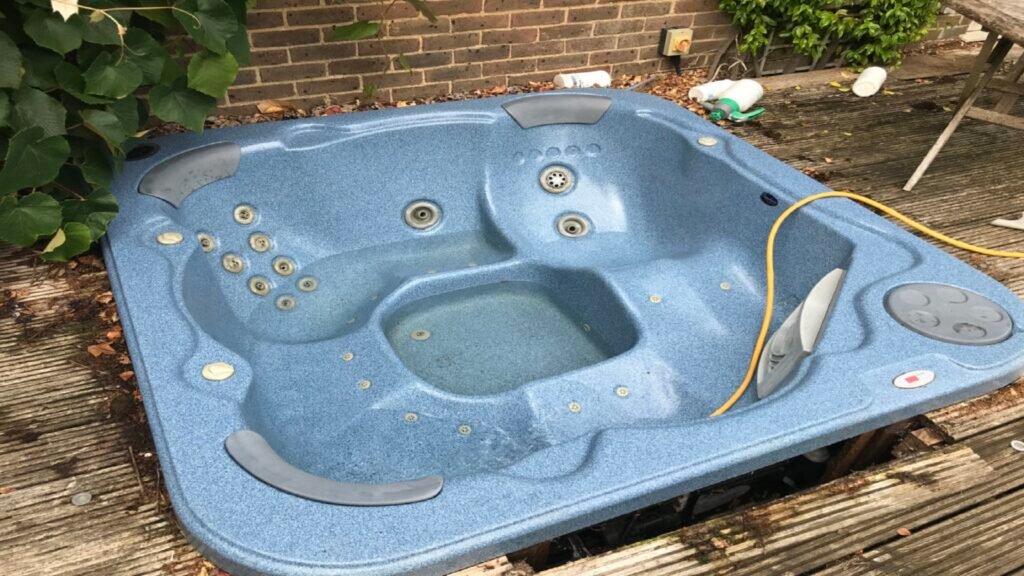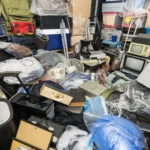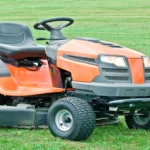Remove all water from hot tub pipes, use a wet/dry vacuum to blow out the water. Open all jets to ensure thorough drainage. Maintaining your hot tub is crucial for its longevity and performance. Draining the water from the pipes prevents freezing and bacterial buildup, especially during off-seasons. Start by turning off the power to ensure safety. Attach a wet/dry vacuum to the drain valve and blow out water from the pipes.
Open all jets to let the water flow out completely. Repeat the process if needed to ensure no water remains. Regular maintenance like this keeps your hot tub in top condition and ready for use. Properly draining your hot tub pipes is essential for preventing damage and ensuring a clean, hygienic soaking experience.
Importance Of Draining Pipes
Hot tubs are a great way to relax. But, it is important to keep them clean. Draining the pipes is a key step. Water left in the pipes can cause problems. This guide will help remove all water from hot tub pipes. It will also explain why draining is important.
Preventing Damage
Water left in hot tub pipes can cause damage. Freezing temperatures can make the water expand. This can crack the pipes. Leaks may occur, and repair costs can be high. Removing all the water stops this from happening.
Stagnant water can also lead to bacteria growth. This can make the hot tub unsafe. Draining the pipes prevents bacteria buildup. Keeping the pipes dry is key to maintaining a clean hot tub.
- Turn off the power
- Drain the main water using a hose
- Use a shop vac to remove water from the pipes
- Check for any remaining water
These steps help ensure all water is removed. Preventing damage is easier than fixing broken pipes. Regular maintenance is crucial.
Improving Maintenance
Proper maintenance keeps your hot tub in good condition. Draining the pipes is part of this process. Clean pipes lead to a longer lifespan for your hot tub. It also ensures the water stays clean and safe.
Regularly cleaning the pipes helps to avoid buildup. Minerals and debris can clog the pipes. This makes the hot tub less efficient. Draining and cleaning the pipes helps to keep everything running smoothly.
- Drain and clean the pipes every 3 months
- Use a pipe cleaner solution
- Inspect pipes for any signs of wear
- Refill with clean water
Following these steps ensures your hot tub stays in top shape. Regular maintenance reduces the risk of major issues. It also helps you enjoy your hot tub without worry.
Tools Needed
Remove all water from hot tub pipes is important. It prevents damage and keeps the hot tub clean. Having the right tools and gear makes the process easier. This guide helps you get started with the necessary equipment and safety gear.
Basic Equipment
To remove all water from hot tub pipes, you need some basic tools. These tools help you do the job effectively.
- Submersible Pump: This pump helps remove large amounts of water quickly.
- Wet/Dry Vacuum: This vacuum is useful for sucking out the remaining water.
- Garden Hose: The hose helps you direct water away from the hot tub.
- Bucket: Use a bucket to catch any water that spills.
- Towels: Towels help you dry any leftover water.
Each of these tools serves a specific purpose. They make sure no water is left behind in the pipes. It’s important to have all these tools ready before you start.
Safety Gear
Using safety gear is crucial when working with water and electrical devices. This gear protects you from accidents.
- Rubber Gloves: Gloves protect your hands from electrical shocks and chemicals.
- Safety Goggles: Goggles keep water and debris away from your eyes.
- Non-Slip Shoes: These shoes prevent you from slipping on wet surfaces.
- Protective Clothing: Wear clothes that cover your skin to avoid any splashes.
Always use safety gear. It keeps you safe and makes the job easier. Safety should be your top priority when working with water and electricity.
Step-by-step Draining Process
Remove all water from hot tub pipes is important. Water left in the pipes can freeze. This can cause damage to your hot tub. Follow this step-by-step draining process to ensure your hot tub is safe and dry.
Turn Off Power
Before starting, make sure to turn off the power. This is important. Water and electricity do not mix. Safety should be your first concern. Find the circuit breaker that controls your hot tub. Flip the switch to the “off” position. Double-check to make sure the power is off.
Here are the steps to turn off the power:
- Locate the circuit breaker panel.
- Find the switch labeled for the hot tub.
- Flip the switch to the “off” position.
- Test the hot tub to ensure it is off.
Also, unplug any additional electrical components. This includes lights, pumps, and heaters. This step ensures complete safety. Remember, always prioritize safety first.
Drain The Hot Tub
Next, you need to drain the hot tub. Start by finding the drain valve. It is usually located at the bottom of the tub. Attach a garden hose to the drain valve. Run the other end of the hose to a safe draining area.
Here are the steps to drain the hot tub:
- Find the drain valve on your hot tub.
- Attach a garden hose to the valve.
- Place the other end of the hose in a safe draining area.
- Open the drain valve and let the water flow out.
Make sure all the water has drained out. This may take some time. Check the hose periodically to ensure it is draining properly. Once all the water is out, close the drain valve. Remove the hose and store it away.
Some hot tubs have a secondary drain or air blower. Use these to remove any remaining water. This ensures the pipes are completely dry.
Blowing Out Pipes
Remove all water from hot tub pipes is crucial. It prevents damage from freezing temperatures. Blowing out pipes ensures all water is gone. Let’s explore the best methods to do this effectively.
Using An Air Compressor
Using an air compressor is efficient. It helps push out water quickly.
Follow these steps for best results:
- Turn off the power to the hot tub.
- Drain the water from the hot tub.
- Attach the air compressor to the blower or jet.
- Set the compressor to a low pressure, around 30 psi.
- Blow air through the pipes. Start with the jets.
Repeat the process for each jet. Check for any remaining water. An air compressor makes the job easier and faster. But, be careful with the pressure settings. High pressure can damage the pipes.
Manual Methods
Manual methods also work well. These do not need special tools.
Follow these steps to manually remove water:
- Turn off the power and drain the tub.
- Use a shop vac to suck out water from the pipes.
- Blow air through the pipes using a wet/dry vac.
- Use a sponge to soak up remaining water.
Manual methods take more time. They are effective if done correctly. Always ensure the pipes are dry. Even a little water can cause problems. Regular maintenance keeps your hot tub in good shape.
Cleaning and Sanitizing
Maintaining a hot tub involves more than just balancing chemicals. It’s crucial to remove all water from the hot tub pipes to prevent bacteria growth and ensure a clean and safe environment. Proper cleaning and sanitizing can make your hot tub experience more enjoyable and prolong the lifespan of your tub. Let’s dive into the steps to remove all water from the hot tub pipes and ensure they are clean and sanitized.
Removing Residue
Residue can build up in hot tub pipes over time. This residue can include soap, oils, and dirt. To remove it, follow these steps:
- Drain the hot tub completely. Use a sump pump or the built-in drain valve.
- Inspect the pipes for visible residue. You might need a flashlight.
- Use a shop vac to blow out the remaining water in the pipes. Insert the hose into each jet and suction point.
- Wipe down the interior of the tub with a clean, soft cloth. This helps remove any leftover debris.
Regularly removing residue can prevent clogged pipes and ensure smooth water flow. This step is essential for the overall health of your hot tub.
Using Chemicals
Chemicals play a vital role in keeping hot tub pipes clean. They help sanitize and break down any organic material.
Here’s a simple guide:
- Add pipe cleaner to your hot tub water. Follow the manufacturer’s instructions for the correct amount.
- Run the jets for about 15-30 minutes. This allows the cleaner to circulate and work effectively.
- Drain the water from the hot tub once again. This will remove the dislodged debris and cleaner.
- Refill the hot tub with fresh water. Ensure all chemicals are flushed out.
Use chemicals safely and store them out of reach of children. Proper chemical use ensures your hot tub stays clean and hygienic.
Final Checks
Remove all water from hot tub pipes is crucial, especially before storing it for winter. This prevents freezing and damage to the pipes. Performing final checks ensures no water is left, which can cause issues later. Here is a guide on how to do these final checks and prepare your hot tub for storage.
Inspecting For Leftover Water
Draining the hot tub is not enough. Water may still remain in the pipes.
Follow these steps to ensure all water is removed:
- Turn off the power to the hot tub.
- Remove the drain plug and let the water flow out.
- Use a wet/dry vacuum to suck out any remaining water from the pipes.
After vacuuming, check the pipes again. Feel for any moisture or wet spots. Dry the pipes with a towel if needed.
For extra caution, blow air through the pipes. Use an air compressor or a leaf blower. This ensures no water is left behind. Repeat the process until you are sure the pipes are dry.
Preparing For Storage
Once the pipes are dry, it is time to prepare the hot tub for storage. Clean the hot tub thoroughly before storing it. This prevents mold and mildew from forming. Remove all filters and clean them as well.
Next, cover the hot tub with a tight-fitting cover. This keeps out dirt and debris. If possible, store the hot tub indoors. This protects it from harsh weather conditions. If storing outdoors, make sure the cover is secure and waterproof.
Inspect the cover regularly. Ensure it remains in good condition. Tighten any loose straps and replace damaged parts. Check for any signs of wear and tear.
Follow these steps to keep your hot tub in great condition. Proper storage extends the life of your hot tub. It ensures it is ready for use when needed.
Conclusion
Draining hot tub pipes is essential for maintenance and longevity. Follow these steps to ensure a thorough cleaning. A well-maintained hot tub offers better performance and longer lifespan. Regularly check and clean your hot tub to enjoy a relaxing, hassle-free experience.
Keep your hot tub in top condition for many years.







